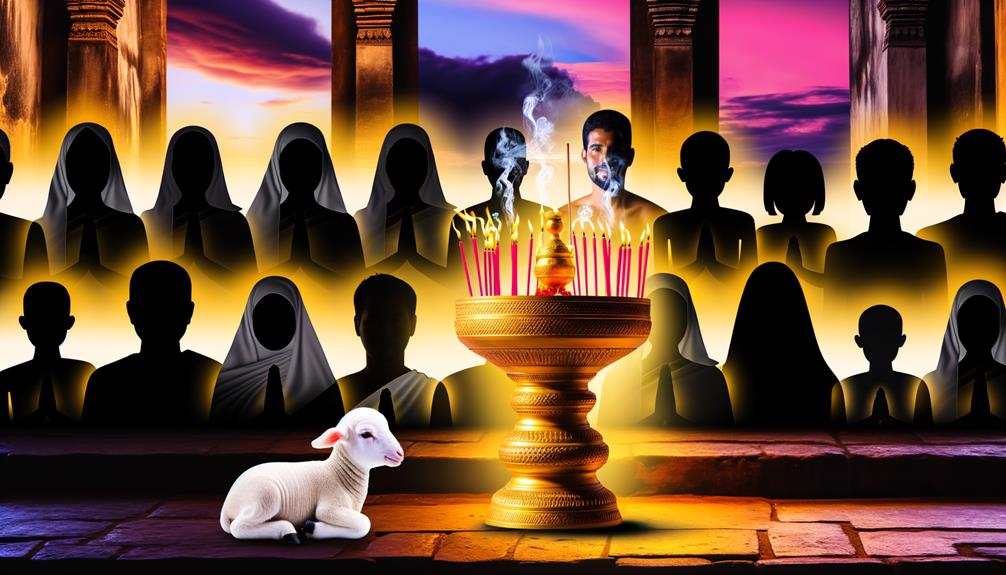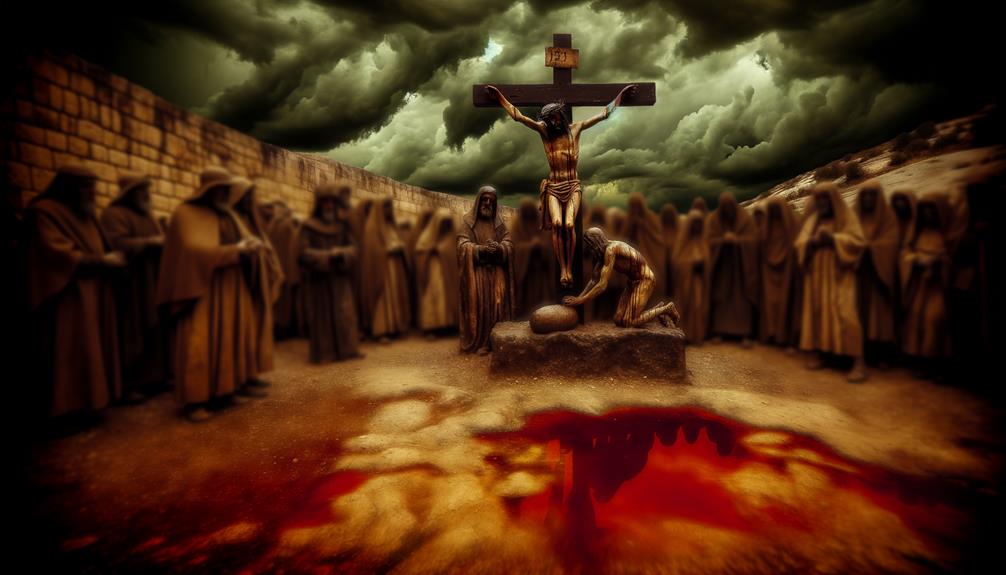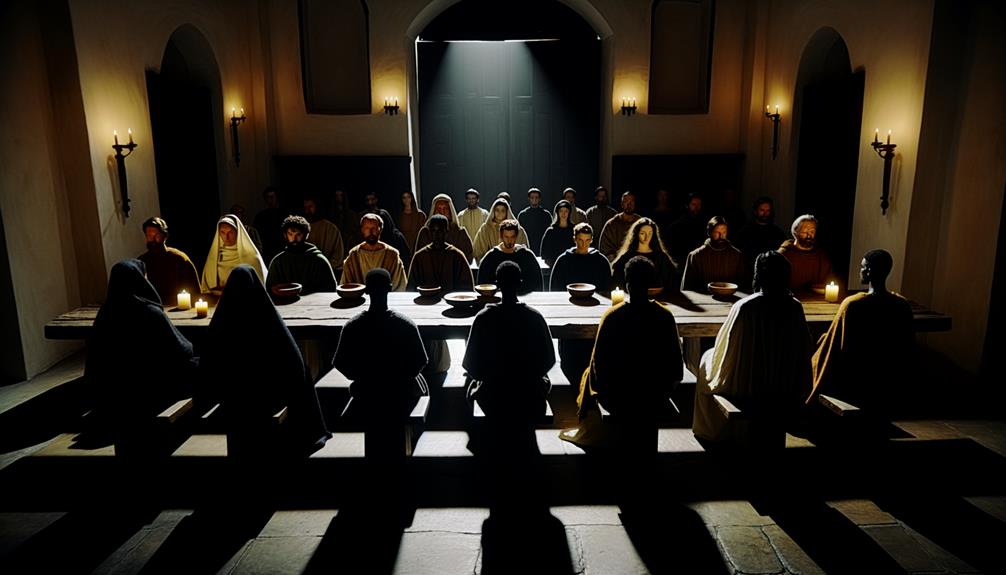Solemn Meaning in the Bible: Sacred Seriousness Defined
In the Bible, ‘solemn‘ signifies a profound sense of reverence and gravity, prominently evident in divine covenants, rituals, and ethical teachings. Abraham’s covenant establishes a foundational divine promise underscoring faith and chosenness.
The Ten Commandments offer a pivotal ethical code, while the Day of Atonement emphasizes purification and communal sanctity. The Last Supper and Jesus’ crucifixion reflect solemn themes of sacrifice and redemption that culminate in a new covenant.
Prophetic visions and the symbolic imagery in Revelation underline the seriousness of divine justice and eschatological hope. Understanding ‘solemn’ in this framework illuminates its deep theological significance.

Solemn Meaning in the Bible: Sacredness and Spiritual Depth
| Aspect | Details |
|---|---|
| Word | Solemn |
| Language Origin | Latin sollemnis, meaning customary or sacred |
| Biblical Usage | Often used in relation to assemblies, feasts, or covenants |
| Meaning | Sacred, serious, deeply reverent |
| Context Examples | “Blow up the trumpet in the new moon, in the time appointed, on our solemn feast day.” |
| Associated Themes | Worship, reverence, covenant, sacred observance |
The Covenant With Abraham

The Covenant with Abraham, as delineated in the Book of Genesis, represents a foundational moment in biblical theology, encapsulating a divine promise that establishes a perpetual relationship between God and Abraham’s descendants.
This covenant, articulated through a series of divine communications, signifies a mutual commitment: God pledges to make Abraham the father of a great nation, promising land and blessings, while Abraham and his progeny are to uphold specific moral and ritual obligations.
The theological implications are profound; it introduces the notion of chosenness and sets the stage for the Israelites’ unique covenantal identity.
This pact underscores themes of faith, obedience, and divine fidelity, forming a cornerstone for subsequent biblical narratives and theological developments.
The Ten Commandments

Among the most pivotal elements of biblical law, the Ten Commandments stand as a succinct yet thorough ethical code that has profoundly influenced Judeo-Christian moral and legal frameworks.
These divine injunctions, delivered to Moses on Mount Sinai, encapsulate fundamental principles of human conduct and societal order. The Decalogue, as it is academically termed, spans directives concerning both divine-human relationships and interpersonal ethics.
It emphasizes monotheism, reverence for God, and sanctity of life, property, and personal integrity. While rooted in ancient Near Eastern covenant traditions, the Ten Commandments transcend cultural and temporal boundaries, offering timeless guidance.
Their enduring relevance underscores their profound impact on theological doctrines, legal systems, and ethical reflections within and beyond religious contexts.
The Day of Atonement

Central to the liturgical calendar of ancient Israel, the Day of Atonement, or Yom Kippur, serves as a profound expression of penitence and reconciliation within the Jewish tradition.
This solemn day, described in Leviticus 16, mandates a series of intricate rituals overseen by the High Priest. The rituals include the offering of sacrifices, the sprinkling of blood, and the symbolic transfer of the community’s sins onto a scapegoat, which is then sent into the wilderness.
These practices underscore the theological themes of purification and divine forgiveness.
Yom Kippur’s significance extends beyond individual atonement, emphasizing communal sanctity and the restoration of the covenantal relationship between God and His people, reflecting a deep yearning for spiritual renewal.
The Prophetic Visions

Revealing the profound depths of divine communication, prophetic visions in the Bible serve as conduits for God’s messages to His people, often providing guidance, warnings, and revelations about the future.
These visions, recorded by prophets such as Isaiah, Ezekiel, and Daniel, are rich with symbolic imagery and metaphoric language, necessitating careful exegesis. They function not merely as foretelling tools but as theological constructs that reinforce covenantal themes, divine justice, and eschatological hope.
The visions often address immediate historical contexts while simultaneously pointing to ultimate divine purposes. For instance, Ezekiel’s vision of the valley of dry bones (Ezekiel 37) symbolizes Israel’s restoration, embodying both a literal and spiritual renewal.
Hence, prophetic visions encapsulate the intricate interplay between divine sovereignty and human history.
The Crucifixion of Jesus

The Crucifixion of Jesus encapsulates a profound narrative of suffering and redemption, beginning with His painful journey towards Golgotha, a site of immense theological significance.
At this pivotal location, the final utterances of Jesus resonate with deep spiritual and eschatological implications, marking the culmination of His earthly mission.
These elements collectively underscore the solemnity and enduring impact of this cornerstone event in Christian theology.
Jesus’ Painful Journey
How does the crucifixion of Jesus encapsulate the profound theological and existential themes central to Christian doctrine?
The crucifixion serves as the focal point of redemptive suffering and divine love. Theologically, it underscores the concept of atonement, where Jesus’ sacrificial death reconciles humanity with God, embodying ultimate obedience and self-giving love.
Existentially, it confronts the human condition of suffering and mortality, offering a paradigm of hope and resurrection. This duality—divine justice and mercy, human despair and redemption—reflects the deep interconnection between the divine and the human.
Furthermore, it invites believers to participate in the transformative power of suffering, urging them to find meaning and purpose through faith, even in the face of profound anguish and sacrifice.
Significance of Golgotha
Golgotha, often referred to as ‘the place of the skull,’ holds immense theological and historical significance as the site of Jesus’ crucifixion, encapsulating the intersection of divine prophecy and human history.
This locale, mentioned in all four Gospels, is symbolic of humanity’s sin and the redemptive act of Jesus’ sacrifice.
Theologically, it fulfills Old Scriptures prophecies, particularly Isaiah 53:5, which foretells the suffering servant.
Historically, Golgotha‘s proximity to Jerusalem underscores its accessibility and visibility, amplifying its impact on early Christian witnesses.
The crucifixion at Golgotha is pivotal, representing the culmination of Jesus’ earthly ministry and the inauguration of a new covenant, making it a cornerstone of Christian faith and soteriology.
Last Words Spoken
Jesus’ final utterances on the cross, recorded across the Gospels, offer profound theological insights and encapsulate the depth of His sacrificial love and divine mission. These last words, articulated amidst immense suffering, present a rich tapestry of meaning:
- ‘Father, forgive them, for they know not what they do’ (Luke 23:34): This plea for forgiveness highlights Jesus’ boundless compassion and the redemptive purpose of His crucifixion.
- ‘My God, my God, why have you forsaken me?’ (Matthew 27:46): This expression of anguish underscores His identification with human suffering and fulfills Psalm 22, affirming His messianic role.
- ‘It is finished’ (John 19:30): This declaration signifies the completion of His redemptive work, bringing to fruition the divine plan for salvation.
The Last Supper

The Last Supper, a pivotal event narrated in the Synoptic Gospels, holds profound theological significance as it marks the institution of the Eucharist and the foretelling of Jesus’ imminent sacrifice.
This momentous occasion, occurring on the eve of the Passover, symbolizes the new covenant between God and humanity, encapsulated in Jesus’ words, ‘This is my body’ and ‘This is my blood.’
Through the sharing of bread and wine, Jesus establishes a perpetual ritual for his followers, signifying his enduring presence and the redemption of sins.
The Last Supper also serves as a poignant reminder of betrayal, with Jesus predicting Judas Iscariot’s actions, thereby intertwining themes of loyalty, sacrifice, and divine foreknowledge within this sacred narrative.
The Book of Revelation

The Book of Revelation, replete with rich symbolism and prophetic visions, serves as a complex tapestry of end times imagery.
Its vivid portrayals of apocalyptic events and celestial phenomena have been the subject of extensive theological analysis and scholarly debate.
Understanding these elements is essential for grasping the solemn messages intended by this enigmatic final book of the New Covenant.
Symbolism and Prophecies
Interpreting the profound symbolism and intricate prophecies within the Book of Revelation requires a nuanced understanding of its eschatological context and theological significance. The text employs vivid imagery and allegorical language to convey its messages, necessitating a careful and contextual examination.
Three key elements in Revelation’s symbolism and prophecies include:
- The Seven Seals: Representing divine judgments and the unfolding of God’s plan for humanity.
- The Beast: Symbolizing oppressive political powers and anti-Christian forces.
- The New Jerusalem: Depicting the ultimate restoration and eternal dwelling place for the faithful.
Each symbol interweaves with apocalyptic themes, urging readers to reflect on the broader spiritual and moral implications of the prophetic visions. Understanding these symbols enriches one’s grasp of biblical eschatology and theological narratives.
End Times Imagery
End times imagery within the Book of Revelation encapsulates a rich tapestry of apocalyptic visions that demand a thorough exegetical and hermeneutical approach.
This eschatological text, replete with symbolic language and vivid metaphors, challenges scholars to decode its layered meanings.
Central to its narrative are the Four Horsemen, the Seven Seals, and the final battle of Armageddon, each serving as a potent symbol of divine judgment and cosmic upheaval.
Interpreters must consider historical context, literary genre, and theological significance to unravel its complex messages.
The imagery not only conveys impending doom but also offers hope for divine justice and ultimate renewal, inviting readers to reflect on moral and spiritual preparedness for the end times.
Conclusion
The biblical concept of solemnity is intricately woven into pivotal events such as the Covenant with Abraham, the Ten Commandments, the Day of Atonement, prophetic visions, the Crucifixion of Jesus, the Last Supper, and the Book of Revelation.
Significantly, the Day of Atonement, or Yom Kippur, remains one of the most sacred observances, drawing the participation of over 70% of Jewish adults annually.
This statistic underscores the enduring significance of solemnity in religious traditions and its profound impact on contemporary spiritual practices.






